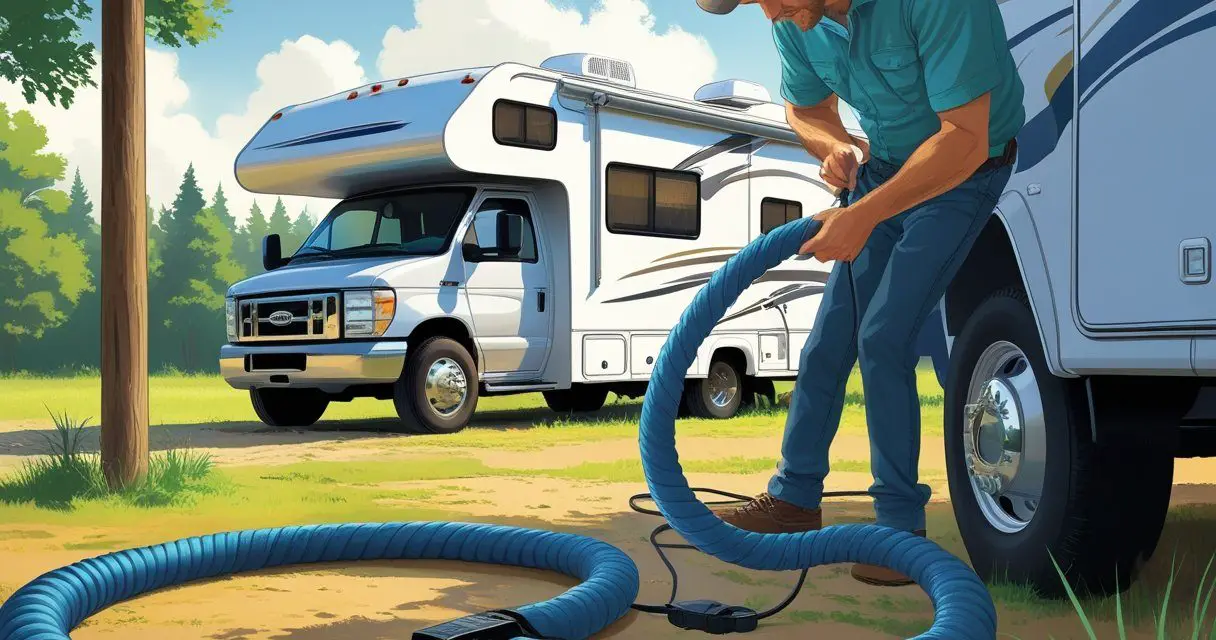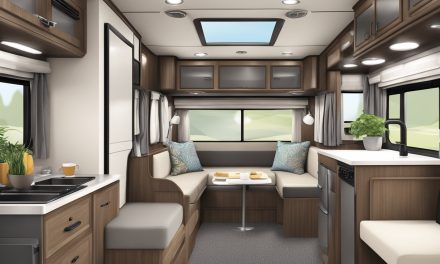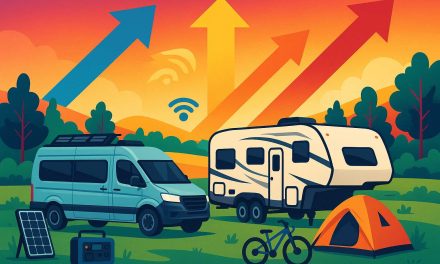Would you like to save this article?
Yes, you can use an extension cord for your RV, but it’s not as simple as grabbing any cord from the garage. You must match the cord to your RV’s power needs to avoid damage, power loss, or even fire hazards.
The right cord keeps your appliances running safely and your setup worry-free.
When you connect your RV, the size, length, and type of cord all matter. Using the wrong one can lead to overheating or underpowered equipment.
Choosing the correct gauge and amperage ensures you get steady power without risking your RV’s electrical system.
By understanding what makes an extension cord safe for RV use, you can avoid common mistakes and keep your setup reliable whether you’re at home or at the campground.
Key Takeaways
- You can use an extension cord with your RV if it matches your power needs
- The right cord size and length prevent overheating and power loss
- Safe use depends on proper setup, routine checks, and avoiding common mistakes
Can I Use an Extension Cord for My RV?
You can use an extension cord with your RV, but only if it is the right type and properly rated. Using the wrong cord can lead to overheating, voltage drops, or even fire hazards.
The key factors are amperage, cord length, and build quality.
When It’s Safe to Use an Extension Cord
It is safe to use an extension cord with your RV when the cord matches the electrical service of your rig. Most RVs use either 30-amp (three-prong) or 50-amp (four-prong) plugs, so you should only use RV extension cords designed for those ratings.
Choose the shortest cord possible that still reaches the power pedestal. Cords longer than 50 feet often cause voltage drops, which can damage appliances like air conditioners or refrigerators.
Durability also matters. Look for heavy-duty RV extension cords with thick insulation and weather resistance.
Many RV cords are made with 10-gauge wire for 30 amps or 6-gauge wire for 50 amps, which can safely handle the load.
Using a surge protector between the pedestal and your cord adds another layer of safety. This protects your RV’s electrical system from power spikes or irregular voltage.
Situations Where Extension Cords Are Not Recommended
You should avoid using a standard household extension cord with your RV. These cords are usually too thin and not rated for high amperage.
They can overheat quickly, melt, or fail under the heavy draw of RV appliances. It’s also not recommended to connect multiple extension cords together.
Linking cords increases resistance and creates more opportunities for voltage drop, which can damage sensitive electronics. If the pedestal is extremely far away, it’s better to move your RV closer or use a properly rated long RV extension cord rather than chaining smaller cords.
Avoid using cords in wet or muddy areas without protection. Even though RV cords are made for outdoor use, keeping the connection points elevated reduces the risk of water exposure.
Potential Risks of Improper Use
Using the wrong extension cord can cause several problems. Overheating is one of the most common issues, especially if the cord is undersized for the amperage.
Overheated wires can melt insulation and create a fire hazard. Another risk is voltage drop.
When the cord is too long or not heavy enough, the voltage reaching your RV drops below safe levels. This can make appliances run poorly or damage motors and electronics.
Improper use can also lead to damaged plugs or outlets. Pulling on the cord instead of the plug, or using a cord with worn connectors, can loosen wiring and create dangerous arcing.
Finally, water exposure is a serious hazard. If connections sit in puddles, electricity can short out or shock anyone nearby.
Keeping cords dry and elevated prevents this risk.
Choosing the Right Extension Cord for Your RV
The extension cord you use with your RV must safely handle the electrical load, fit the correct plug type, and withstand outdoor conditions. Paying attention to amperage, wire gauge, length, and durability helps prevent overheating, voltage drop, and equipment damage.
Matching Amperage and Voltage Requirements
Your RV will either use a 30-amp or 50-amp power system. A 30-amp RV typically runs on 120 volts with a maximum of 3,600 watts, while a 50-amp RV can draw up to 12,000 watts at 240 volts.
Always choose an extension cord that matches your RV’s amperage rating. Using a cord rated for less current than your RV requires can overheat the wire and damage appliances.
A 30-amp RV extension cord usually has a NEMA TT-30 plug with three prongs. A 50-amp cord has a NEMA 14-50 plug with four prongs.
Check the label near your RV’s power inlet to confirm which type you need. If you only plan to run light loads, such as charging batteries, you may use adapters.
However, adapters reduce available power and should not replace the correct cord for regular use.
Differences Between Standard and RV Extension Cords
A household extension cord is not designed for RV power needs. Standard cords are thinner, have lower amperage ratings, and can overheat when used with high-draw appliances like air conditioners or microwaves.
An RV extension cord is built with thicker copper wiring, heavy-duty insulation, and molded plugs that fit campground pedestals. These cords are often labeled with their gauge and amperage rating for easy identification.
RV cords also include weather-resistant jackets, making them safer for outdoor use. Many feature twist-lock or snug-fitting connectors that reduce the risk of loose connections, which can cause arcing or burn marks on plugs.
Using the wrong type of cord may seem convenient, but it creates a fire hazard and shortens the life of your RV’s electrical system.
Recommended Cord Lengths and Gauge
Cord length and wire gauge directly affect performance. Longer cords increase resistance, which causes a voltage drop.
Too much voltage drop can make lights flicker or prevent appliances from starting. For a 30-amp RV, a 10-gauge cord works well up to 25–50 feet.
If you need more than 75 feet, step up to an 8-gauge cord. For a 50-amp RV, a 6-gauge cord is the standard choice, especially over longer distances.
| RV Amperage | Typical Gauge | Max Practical Length |
|---|---|---|
| 15 amps | 12–14 AWG | 50–70 ft |
| 30 amps | 10 AWG | 25–50 ft |
| 50 amps | 6–8 AWG | 25–50 ft |
Always use the shortest cord that still reaches the power source. This reduces heat buildup and keeps your RV’s electrical system stable.
Weatherproof and Outdoor-Rated Options
Because you often connect your RV outdoors, the extension cord must withstand rain, sun, and temperature changes. Look for cords rated STW or SJTW, which indicate heavy-duty, outdoor-safe insulation.
A good RV extension cord should be flexible enough to coil in cold weather but tough enough to resist cracking or abrasion. Many have molded ends with strain relief to protect the connection points.
Waterproof or twist-lock connectors add another layer of safety, especially in damp campsites. Some cords also include indicator lights to confirm power is flowing, which helps you troubleshoot quickly if there’s a problem.
Never use an indoor-only cord outside, even temporarily. Moisture and UV exposure can break down the insulation and increase the risk of electrical shock or fire.
Always confirm the cord is specifically rated for outdoor RV use.
How to Safely Connect Your RV Using an Extension Cord
You need to match the extension cord to your RV’s electrical service, use the right adapters when necessary, and keep cord length under control to avoid power loss.
Step-by-Step Connection Process
Start by checking your RV’s electrical service rating. Most RVs use either 30-amp or 50-amp service.
Make sure the RV extension cord you choose matches that rating. Using the wrong cord can cause overheating or damage.
Before plugging in, inspect the cord for cuts, frays, or bent prongs. Do not use a damaged cord.
Place the cord on dry ground and avoid running it through standing water. When connecting, follow this order:
- Plug the RV extension cord into the campground pedestal or power source.
- Attach a surge protector between the pedestal and the cord if you have one.
- Connect the other end of the cord securely to your RV’s power inlet.
Always push the plug fully into place and use locking ends if available. When disconnecting, pull from the plug, not the cord, to prevent internal wire damage.
Using Adapters and Power Converters
Some campgrounds only offer outlets that don’t match your RV’s plug type. In these cases, you may need an adapter, often called a dog bone adapter.
For example, you might use a 30-amp to 50-amp adapter if your RV requires 50 amps but only 30 amps are available. Keep in mind that an adapter does not increase available power.
If you plug a 50-amp RV into a 30-amp outlet, you can only draw 30 amps safely. Exceeding that limit can trip breakers or damage equipment.
It’s also useful to carry a power converter or adapter for 15- or 20-amp household outlets. These should only be used for light loads, such as charging batteries, not for running high-demand appliances like air conditioners.
Minimizing Voltage Drop
Long extension cords can cause voltage drop, which lowers the power reaching your RV. This can make appliances run poorly and may shorten their lifespan.
To reduce this risk, use the shortest RV extension cord possible. Choose a cord with the correct wire gauge for the amperage.
For example:
| RV Service | Recommended Cord Gauge | Max Length (approx.) |
|---|---|---|
| 30-amp | 10-gauge | 25–50 feet |
| 50-amp | 6-gauge | 25–50 feet |
Avoid daisy-chaining multiple cords together. Each connection increases resistance and heat buildup.
If you must extend beyond 50 feet, consider a heavier gauge cord rated for longer runs instead of stacking smaller cords. Keep cords uncoiled when in use, since tightly coiled cords trap heat and worsen voltage drop.
Regularly check connections for warmth during use, as heat is a sign of power loss or overload.
Common Mistakes and How to Avoid Them
When powering your RV with an extension cord, the main risks come from drawing too much power, using the wrong type of cord, or handling and storing it in unsafe ways.
Overloading Circuits
One of the most common mistakes is plugging too many devices into a single extension cord. RVs often run high-demand appliances like air conditioners, microwaves, or space heaters.
These can easily exceed what a standard household extension cord is rated for. Most light-duty cords handle only 1,500–1,800 watts.
A single RV air conditioner can use close to 1,500 watts, leaving little room for anything else. Adding another large appliance can quickly overload the cord, leading to overheating or tripped breakers.
To avoid this, check the amp rating of both your RV and the extension cord. A 30-amp RV, for example, requires a heavy-duty cord designed for that load.
Use a dedicated RV extension cord when possible, or at minimum, a heavy-gauge outdoor cord rated for the amperage you need.
Using Underrated or Damaged Cords
Another mistake is using an extension cord that is too thin or already damaged. A cord with the wrong gauge can’t safely carry the current your RV requires.
The lower the gauge number, the thicker the wire and the more power it can handle. For RV use, you generally need a 10- or 12-gauge cord.
Using a 14- or 16-gauge household cord may cause voltage drop, which can damage sensitive appliances inside your RV. You should also inspect cords before each use.
Look for burn marks, melted insulation, frayed wires, or a hot plug end. Even small signs of wear can lead to shock or fire hazards.
If the cord feels warm during use, replace it with a heavier-duty option.
Improper Storage and Handling
How you handle and store your extension cord also affects safety and performance. Coiling a cord too tightly or leaving it tangled can cause heat buildup.
Running it under rugs, mats, or through doorways can trap heat or damage the insulation. When storing, loosely coil the cord in large loops and keep it in a dry, ventilated space.
Avoid sharp bends or kinks that weaken the wire over time. If you use the cord outdoors, keep it off wet ground and away from standing water.
Always unplug and store it once you’re finished instead of leaving it exposed to sun and weather.
Best Practices for Long-Term and Temporary Use
Safe use of an RV extension cord depends on how long you plan to draw power, where you connect, and how many appliances you run at the same time. Paying attention to cord rating, outlet capacity, and proper setup helps prevent overheating, tripped breakers, and fire risks.
Short-Term Powering at Home
When you plug your RV into a home outlet for a short time, use a heavy-duty RV extension cord rated for the amperage of your RV (30-amp or 50-amp). A standard household cord is not built for this load and can overheat.
If your RV only needs light power for charging batteries or running a small appliance, a 15-amp adapter may work. Avoid running the air conditioner or microwave through a standard outlet, as these appliances draw too much current.
Keep the cord fully uncoiled to allow heat to escape. Place it on a dry surface and away from walkways to prevent damage.
Always inspect for cracks, frays, or bent prongs before plugging in.
Extended Stays at Campgrounds
Campgrounds usually provide 30-amp or 50-amp hookups designed for RV use. Connect your RV extension cord directly to the pedestal outlet that matches your RV’s service.
Using the correct cord ensures safe, steady power for long-term use. If you need an extension beyond the pedestal, choose a cord that matches your RV’s amperage and length requirements.
Longer cords cause voltage drop, which can damage sensitive electronics. Keep the length as short as possible.
Use a surge protector between the pedestal and your RV extension cord. This helps protect against power spikes and wiring problems at the campground.
Store the cord neatly when not in use to prevent moisture damage or kinks.
Managing Multiple Appliances
Running several appliances at once can overload your RV’s electrical system if you aren’t careful. Heavy loads like air conditioners, microwaves, and space heaters should not run together on the same circuit.
Check the total amperage draw of your appliances and compare it to your RV’s service rating. For example:
| Appliance | Approx. Amps |
|---|---|
| Air Conditioner | 12–15A |
| Microwave | 10–12A |
| Electric Heater | 12–15A |
| Coffee Maker | 6–8A |
Stagger usage when possible. Run the air conditioner while turning off high-draw appliances like the microwave.
This prevents tripped breakers and reduces strain on your RV extension cord. Never daisy-chain multiple extension cords or power strips to add more outlets.
Stick with one properly rated RV extension cord to maintain safe and reliable power.
Maintenance and Safety Tips
Keeping your RV extension cord in good condition reduces the risk of overheating, power loss, or fire. Proper inspection, storage, and awareness of wear help ensure safe and reliable use every time you connect to a power source.
Inspecting Extension Cords Regularly
You should check your extension cord before each use. Look closely at the plug ends, the cord jacket, and the connection points for any cracks, burns, or loose fittings.
Even small defects can cause overheating or poor conductivity. Run your hand along the length of the cord to feel for soft spots, bulges, or cuts.
These can indicate damaged insulation or internal wire issues. If you notice anything unusual, stop using the cord immediately.
It’s also smart to test the cord under load. Plug in your RV and monitor the cord for warmth after 10–15 minutes.
A properly rated extension cord should remain cool to the touch. Warm or hot spots signal a problem with the cord or the connection.
Keep a routine schedule for inspection. A quick monthly check, along with a closer review before long trips, helps catch problems early.
Storing Cords Properly
How you store your extension cord affects its lifespan. Always coil the cord loosely in large loops instead of tight wraps.
Sharp bends or kinks can weaken the insulation and wires over time. Store the cord in a dry, cool place away from direct sunlight.
Prolonged exposure to heat, moisture, or UV light can cause the jacket to crack or degrade. A storage bag or reel keeps the cord organized and protected.
Avoid leaving the cord on the ground for long periods. Dirt, water, and pests can damage the outer jacket.
If you must run it across the ground, use cord covers or elevate it off wet surfaces. When packing your RV, keep the cord separate from sharp tools or heavy gear.
Crushing or cutting the cord during storage can create hidden hazards.
Recognizing Signs of Wear or Damage
Pay attention to common warning signs that your extension cord may no longer be safe. Burn marks, melted plastic, or discoloration near the plug ends often mean overheating has occurred.
Frayed or exposed wires are a clear signal to replace the cord. Even if tape covers the damage, the cord is unsafe for RV use.
Household fixes are not suitable for high-amperage cords. If you notice a strong burning smell or hear crackling when the cord is in use, disconnect it right away.
These are signs of internal arcing or loose connections. Extension cords that frequently trip breakers or cause flickering lights may also be faulty.
Test with another properly rated cord if you suspect an issue. If the problem goes away, retire the damaged one.
Always choose a cord rated for your RV’s amperage to avoid repeating the same issues.





